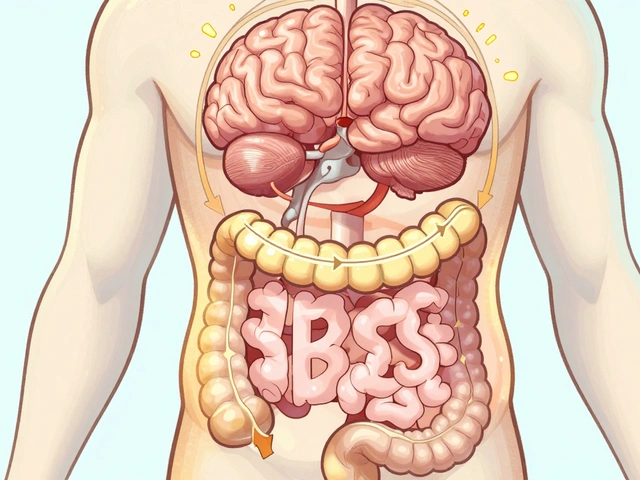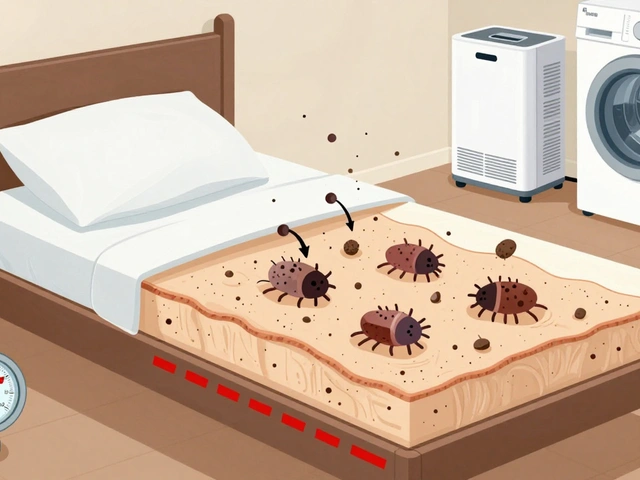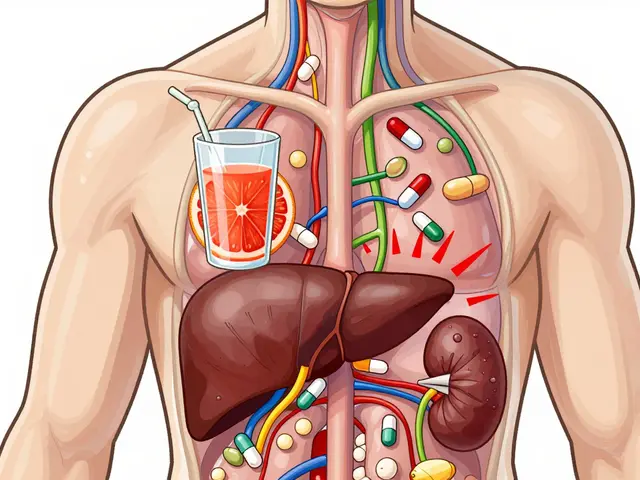Here’s the uncomfortable truth: most people stop bladder meds within a few months-not because the drug can’t help, but because no one taught them how to make it work. Tolterodine can calm urgency and cut bathroom trips, but success isn’t just about a script. It’s about patient education that sets clear expectations, prevents avoidable side effects, and builds habits that stick.
TL;DR
- Expect steady benefits after 2-8 weeks, not overnight. Track progress with a 3-day bladder diary.
- Pick the right dose and formulation (often extended-release) and take it the same time daily.
- Prevent dry mouth and constipation early; these two side effects drive most drop-offs.
- Pair the medicine with bladder training, pelvic floor work, and smart fluid/caffeine habits.
- Have a review plan at 4-8 weeks to tweak dose, switch meds, or stop if you’re not improving.
Why Patient Education Makes Tolterodine Work (And What to Teach)
If your bladder feels like it’s running the show-urgent dashes, frequent trips, sometimes leaks-you’re not alone. Overactive bladder (OAB) is common, especially with age. tolterodine (an antimuscarinic) helps by relaxing the bladder muscle so it doesn’t misfire with every hint of fullness. That’s the science. The real-world catch? Without good guidance, the most likely outcome is stopping early.
What does “good guidance” cover? Three things: realistic timelines, side effect prevention, and a simple plan to build new habits. NICE (UK) and AUA/SUFU (US) guidelines updated through 2024 both stress this: education and behavioral strategies boost results and cut discontinuation. A 2023 Cochrane review found antimuscarinics like tolterodine beat placebo for urgency, frequency, and leaks-but drop-out rates climb without support. A real-world adherence study in 2022 reported 30-50% of users stopping by 3 months; structured follow-up and coaching improved persistence by 15-20%.
Set expectations upfront. Most people notice fewer urgency episodes and longer gaps between bathroom visits over 2-4 weeks. Leaks usually improve next. Some need 6-8 weeks for a fair trial. Expect “better,” not “perfect.” For many, that means cutting bathroom trips by 1-2 per day and trimming leaks by a few per week. It’s a win when you can finish a meeting, drive across town, or sleep an extra hour.
Side effects are predictable and manageable if you get ahead of them. Dry mouth and constipation are the big two. Blurred vision, heat intolerance (less sweating), and sometimes dizziness can show up too. Older adults can be more sensitive, especially to cognitive side effects with drugs that add to anticholinergic burden. The way to win is to prevent problems before they chase you off the medication.
One more piece many people miss: formulation matters. Extended-release (ER) tolterodine tends to cause less dry mouth than immediate-release (IR), and it’s easier to remember once daily. In my clinic in Perth, a quick switch from IR to ER keeps plenty of people on therapy who would have quit.
Jobs-to-be-done this guide covers:
- Understand how tolterodine works and what benefits to expect, by when.
- Pick the right dose/form and take it correctly to avoid common pitfalls.
- Prevent and manage side effects without giving up early.
- Use simple lifestyle tactics that multiply the medication’s effect.
- Know when to call your healthcare professional and what to try next if it’s not working.

Your Step-by-Step Plan: Dosing, Habits, and Side Effect Control
Start with the best fit:
- Formulation: ER once daily is usually easier and gentler on the mouth; IR twice daily can suit those who need more flexible adjustments.
- Typical dosing: ER 2-4 mg once daily, or IR 1-2 mg twice daily. Many start at ER 2 mg and adjust to 4 mg after 2-4 weeks if needed and tolerated.
- Liver/kidney issues, or strong CYP3A4 inhibitors (e.g., some antifungals, macrolide antibiotics): use the lower dose and do not up-titrate without medical advice.
- Swallow ER capsules whole. Don’t crush or open.
- Timing: take it the same time daily. Morning suits most people; bedtime can help if you’re drowsy but watch for nighttime dry mouth.
What to expect, week by week:
- Week 1-2: small wins-longer gaps between trips, slightly quieter urgency. Dry mouth may show early; constipation can creep in by week two.
- Week 3-4: clearer benefit-fewer urgency leaks, more control. Adjust dose here if you started low.
- Week 6-8: “final answer” period-decide with your clinician whether to continue, switch, or add a second-line option if progress stalls.
Prevent the side effects that make people quit:
- Dry mouth: sip water regularly; use sugar-free gum or lozenges (xylitol is fine). Keep caffeine and alcohol modest-they dry you out. Use alcohol-free mouthwash.
- Constipation: aim for 25-30 g fibre/day, 1.5-2 L fluids unless restricted. Add a gentle stool softener or osmotic laxative early if you’re prone. Move daily-even a 20-minute walk helps.
- Heat: tolterodine can reduce sweating. In Aussie summers, plan shade, rest breaks, and extra water. Stop and cool down if you feel overheated.
- Vision and driving: if your vision blurs, avoid driving until it clears. Usually transient; mention it at review.
- Urinary retention risk: if you struggle to pass urine, have lower abdominal pain, or feel unemptied after voiding-seek urgent care.
Make the medicine work harder with simple habits:
- Bladder training: choose regular bathroom times (e.g., every 2-3 hours). If urgency strikes early, delay by 5-10 minutes, then go. Stretch the interval each week.
- Pelvic floor: short, focused squeezes (10 reps, 3 times/day). A pelvic physio can fast-track technique. Apps and reminders help.
- Fluid smarts: steady sips over the day; cut back 2-3 hours before bed. Reduce caffeine, artificial sweeteners, and alcohol-these stir up the bladder.
- Weight and activity: even a 5% weight drop can ease symptoms. Gentle cardio helps bowel regularity and mood.
- Bladder diary: track 3 days before starting and again at 4 weeks. Note times, volumes, urgency (0-3 scale), and any leaks. It shows progress you can miss day to day.
Med interactions and cautions (keep it simple, keep it safe):
- Drugs that boost tolterodine levels: strong CYP3A4 inhibitors (e.g., clarithromycin, itraconazole) or certain antidepressants that also block CYP2D6 (e.g., paroxetine, fluoxetine). If you’re on these, stick to the lower dose and check in before any changes.
- Other anticholinergics (e.g., some allergy meds, older antidepressants, some antipsychotics): side effects can stack. Your pharmacist can review your anticholinergic burden.
- Medical conditions: narrow-angle glaucoma, myasthenia gravis, severe constipation, gastric retention, or a history of urinary retention need careful review-sometimes tolterodine isn’t suitable.
- Heart rhythm: very high exposures can affect QT interval. If you have long QT syndrome or take other QT-prolonging meds, flag it with your clinician.
- Pregnancy/breastfeeding: human data are limited; use only if benefits clearly outweigh risks. Ask before starting or continuing.
| Feature | Immediate-Release (IR) | Extended-Release (ER) |
|---|---|---|
| Typical dosing | 1-2 mg twice daily | 2-4 mg once daily |
| Onset you can feel | Some effect within 1-2 weeks | Some effect within 1-2 weeks |
| Best time to take | Morning and evening, with routine | Same time daily, easier adherence |
| Dry mouth rate (trials) | ~25-35% | ~15-25% |
| Constipation rate (trials) | ~8-15% | ~6-12% |
| Who it suits | Those needing fine dose tweaks | Those wanting fewer side effects and once-daily dosing |
Numbers above reflect ranges reported across randomized controlled trials and product information summaries. Differences vary by study design and population.
How we measure success (and adjust):
- Baseline: record 3 days of frequency, urgency, leaks, and triggers. Note all meds you take.
- Start: choose ER 2 mg daily unless there’s a reason to start lower/higher. Build side-effect prevention in from day one.
- Check-in at 2 weeks: if mouth/constipation are fine and urgency is a little better, keep going. If side effects bother you, switch to ER if on IR, drop dose, or add countermeasures (e.g., stool softener).
- Review at 4-6 weeks: if symptoms are at least 50% better or the gains matter to your life (sleep, work, exercise), consider staying the course. If not enough, discuss moving to ER 4 mg or trying an alternative class (e.g., mirabegron) or combination therapy.
- Decide at 8 weeks: continue if benefits outweigh side effects and cost. If not, stop, switch, or re-focus on non-drug strategies.
Australian notes (because context matters): Tolterodine is usually PBS-listed; your pharmacist can confirm your exact item and co-payment. Common brands include Detrusitol and Detrusitol SR. Perth summers are hot-plan around heat if you exercise outdoors. If you’re also on meds like paroxetine or fluconazole, mention it; these can affect tolterodine levels.

Examples, Checklists, and FAQs You Can Use Today
Three quick examples to make this real:
- Office worker, 42: starts ER 2 mg, swaps afternoon coffee for decaf, adds 3 x 10 pelvic floor squeezes. Dry mouth mild with sugar-free gum. At 4 weeks, bathroom trips cut from 12 to 8/day; no leaks.
- Retiree, 71: on IR 1 mg BID with dry mouth and constipation. Switches to ER 2 mg, adds fibre supplement and daily walk. Side effects settle; urgency improves by week 3. Reviews anticholinergic burden with pharmacist due to allergy tablets-stops the older antihistamine.
- Tradie, 55, hot worksites: stays hydrated, cools during breaks, plans bathroom stops. Starts ER 2 mg. Emphasizes heat safety to avoid overheating from reduced sweating.
Pre-start checklist (bring this to your appointment):
- My top three goals (e.g., fewer night trips, no leaks on dog walks, finish a 90-minute meeting).
- Three-day bladder diary completed.
- Current meds list (including OTC and herbal)-highlight antidepressants, allergy meds, patches.
- Constipation risk: yes/no. If yes, plan fibre and a stool softener now.
- Glaucoma history, bowel issues, urinary retention risk: flagged.
Daily routine checklist (stick on your fridge):
- Take ER capsule with breakfast (or the same time daily); IR users-morning and evening.
- Water bottle on desk; sugar-free gum in bag.
- Two short pelvic floor sessions done; third in the evening.
- Bathroom timing set (e.g., 8 am, 11 am, 2 pm, 5 pm, 8 pm).
- Stop caffeine by 2 pm; reduce fluids after dinner.
Review-day checklist (at 4-8 weeks):
- What changed? Frequency, urgency, leaks, sleep. Use your diary.
- Side effects: dry mouth scored 0-10; constipation yes/no; any blurred vision or dizziness?
- Adherence: how many doses missed this week?
- Decision: continue, adjust dose/formulation, switch, or combine with mirabegron.
Mini-FAQ
- How long before I notice results? Some people feel a small change in 7-10 days. Most need 2-4 weeks for clear benefits, and up to 8 weeks for the full picture.
- Is ER better than IR? Many find ER easier to take and a bit kinder on the mouth. If you’re struggling on IR, swapping to ER often helps.
- Can I drink coffee? Yes, but less usually helps. Try cutting to one cup in the morning and see if urgency eases.
- What if I miss a dose? Take it when you remember if it’s the same day. If it’s close to your next dose, skip the missed one. Don’t double up.
- Is it safe with prostate problems? Men with enlarged prostates can benefit, but retention risk is higher. A clinician may check a post-void residual and often pair treatment with an alpha-blocker.
- Could it affect my memory? Any anticholinergic can, especially with multiple similar drugs on board and in older adults. Keep your anticholinergic load low; review your med list with a pharmacist.
- Can I stop if I feel fine? Yes, but talk first. Symptoms can creep back. Some people cycle off after progress with bladder training and restart if needed.
- What if it doesn’t work? Switch to a different antimuscarinic (e.g., solifenacin) or a beta-3 agonist (mirabegron). Combination therapy is common if one drug alone doesn’t cut it.
Evidence and credibility notes:
- NICE Guideline NG123 on urinary incontinence and OAB (2019, updated 2024): education plus bladder training is first-line; meds are second-line and should be reviewed at 4-12 weeks.
- AUA/SUFU Guideline on OAB (2019, amended 2024): sets similar expectations; supports mirabegron or antimuscarinic switching/combination if response is partial.
- Cochrane Review 2023: antimuscarinics reduce urgency/frequency and leaks vs placebo; side effects drive discontinuation without supportive care.
- Australian product information/TGA: dosing, contraindications, interactions, and QT cautions as above.
Teach-back tip (if you’re a clinician): ask the patient to explain how they’ll take the medicine, what side effects they’ll prevent, and when they’ll call. It spots gaps fast.
Simple adherence hacks:
- Pair the capsule with something you never skip (breakfast, teeth brushing).
- Use a weekly pillbox and a phone reminder.
- Keep sugar-free gum in your car and bag for dry mouth.
- Put your bladder diary next to your kettle-fill it out when you make tea.
Special scenarios:
- On paroxetine, fluoxetine, or bupropion: mention it-dose limits may apply.
- Night-time urgency dominates: watch evening fluids; consider ER in the morning plus bladder training to stretch bedtime/overnight intervals.
- Athletes or outdoor workers in summer: plan cooling, shade, and hydration; consider training times in cooler parts of the day.
- Constipation-prone: start fibre and an osmotic laxative early, not later.
When to seek help now:
- Unable to pass urine, lower abdominal pain, or severe constipation-urgent review.
- Persistent blurred vision, confusion, or fainting-stop and call your clinician.
- No improvement after 8 weeks despite good adherence-time to switch strategy.
Personal note from the clinic: people who come back with a completed bladder diary almost always do better. It keeps you honest about habits, and it proves progress even when you don’t feel it day to day. In Perth, I see the biggest wins when we combine ER 2-4 mg, early constipation prevention, and bladder training with a simple reminder routine. Small, boring steps-big, meaningful gains.







15 Comments
Sarah Riley
Tolterodine’s muscarinic M3 antagonism attenuates detrusor overactivity, yet clinicians often undervalue the drug’s plasma half‑life variability, which can skew adherence metrics.
Tammy Sinz
The guide overstates the universality of the 2‑4 mg ER regimen; patients with CYP3A4 inducers demand dose recalibration, otherwise therapeutic windows collapse.
Christa Wilson
Great summary! 😊 The diary tip alone can boost success rates dramatically – keep tracking and celebrate those tiny wins! 🎉
John Connolly
Starting tolterodine on a stable schedule is the cornerstone of any successful OAB regimen.
Patients should ingest the extended‑release capsule with a full glass of water at the same hour each morning to reinforce habit formation.
If morning dosing induces mild xerostomia, a simple switch to bedtime can mitigate discomfort without sacrificing efficacy.
Concomitant fiber supplementation, aiming for 25 g daily, synergizes with the drug by normalizing bowel motility and reducing constipation risk.
Hydration remains critical; however, fluid intake should be evenly distributed and tapered two hours before bedtime to curb nocturia.
Pelvic floor training, performed in three sets of ten quick contractions three times per day, reinforces sphincter control and complements pharmacotherapy.
Bladder training, such as scheduled voiding every three hours, progressively extends intervals and desensitizes urgency cues.
Clinicians must schedule a follow‑up at four weeks to evaluate symptom reduction, side‑effect profile, and adherence patterns.
During this review, a 50 % reduction in urgency episodes justifies continuation, whereas minimal change signals a need for dose adjustment or drug rotation.
Adverse events, particularly dry mouth and constipation, should be addressed proactively with sugar‑free gum and osmotic laxatives, respectively.
For patients on strong CYP3A4 inhibitors, a conservative starting dose of 2 mg daily is advisable to avoid supra‑therapeutic concentrations.
Conversely, individuals with hepatic insufficiency may require closer monitoring of plasma levels and possible dose reduction.
Educational reinforcement, such as teach‑back techniques, ensures patients can articulate their dosing schedule and side‑effect mitigation plan.
Utilizing a weekly pillbox and smartphone reminders boosts compliance, especially in older adults with polypharmacy.
Finally, documenting progress in a bladder diary provides objective data that empower both the patient and the provider to fine‑tune therapy.
Sajeev Menon
One practical tip is to set a reminder on your phone for the same time each day; it helps lock the habit in, especially when juggling work and family duties. Also, consider swapping regular gum for a sugar‑free alternetive to ease dry mouth – it’s a small change that can make a big difference. Remember, consistency trumps intensity when it comes to pelvic floor exercises.
Emma Parker
Hey, don’t forget to sip water all day, not just at meals!
Joe Waldron
Adherence can falter, especially if patients perceive side effects as intolerable; proactive management-such as pre‑emptive lozenges, fiber, and scheduled voiding-mitigates this risk. Moreover, consistent follow‑up reinforces accountability, enabling dose tweaks when needed.
Wade Grindle
I’ve noticed that many folks who pair tolterodine with a simple morning walk report better bladder control, probably due to improved circulation and stress reduction.
Benedict Posadas
Yo! Keep that bladder diary handy – it’s like your personal stats board 😎. If dry mouth hits hard, grab some sugar‑free gum or a small sip of water every hour – trust me, it works!
Jai Reed
Stop ignoring the side‑effect checklist; if you don’t act on dry mouth and constipation now, you’ll quit the medication later.
Sameer Khan
The pharmacokinetic profile of tolterodine is intrinsically modulated by hepatic CYP3A4 enzymatic activity, thereby necessitating individualized dose titration.
In the presence of potent inhibitors such as clarithromycin, the area under the curve can increase by up to 70 %, precipitating amplified anticholinergic adverse events.
Conversely, induction by agents like rifampin reduces systemic exposure, potentially undermining therapeutic efficacy.
Such bidirectional interactions underscore the imperative of comprehensive medication reconciliation at initiation.
Moreover, the anticholinergic burden, quantified via the Anticholinergic Cognitive Burden scale, should be minimized to avert central nervous system sequelae.
Patients with pre‑existing mild cognitive impairment are particularly susceptible to exacerbation when tolterodine is co‑prescribed with other muscarinic antagonists.
Hence, a stratified risk assessment algorithm, integrating renal function, hepatic metabolism, and concomitant drug load, optimizes safety.
Behavioral adjuncts, including timed voiding and pelvic floor biofeedback, synergistically enhance detrusor stability.
Empirical evidence demonstrates that adherence improves by approximately 22 % when such multimodal strategies are systematically implemented.
In clinical practice, the convergence of pharmacologic precision and behavioral reinforcement yields the most robust outcomes.
WILLIS jotrin
When you look at the data, the modest improvement in nocturnal trips often correlates more with fluid timing than with dosage alone.
Kiara Gerardino
It is a travesty that so many patients abandon evidence‑based therapy because they lack proper education; neglecting to empower them is a breach of our professional duty.
Tim Blümel
Let’s keep the momentum going! 🌟 Remember, consistency is your ally, and every small victory builds the bigger picture. 🚀
Joanne Ponnappa
Great info – super helpful! 👍